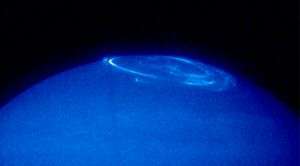Novel spots found on Jupiter

Scientists have observed unexpected luminous spots on Jupiter caused by its moon Io. Besides displaying the most spectacular volcanic activity in the solar system, Io causes auroras on its mother planet that are similar to the Northern Lights on Earth. The auroral emissions linked to the volcanic moon are called the Io footprint.
From previous studies, researchers had found the Io footprint to be a bright spot that is often followed by other auroral spots. Those spots are typically located downstream relative to a flow of charged particles around the giant planet. Now, a team of planetologists from Belgium and Germany have discovered that Io’s footprint can include a faint spot unexpectedly upstream of the main spot.
Each appearance of such a “leading spot” occurs in a distinctive pattern, the scientists say: When the main footprint is preceded by a leading spot in the northern or southern hemisphere of Jupiter, it is also followed by downstream spots in the opposite hemisphere.
“Previously, we only observed downstream spots, but only half of the configurations of Io in the Jovian magnetic field had been studied,” says Bertrand Bonfond of the University of Liège in Belgium, who is a member of the team that found the new type of spot. “Now we have the complete picture. The results are surprising because no theory predicted upstream spots.”
Like a rock in a stream, Io obstructs the flow of charged particles, or plasma, around Jupiter. As the moon disrupts the flow, it generates powerful plasma waves that blast electrons into Jupiter’s atmosphere, creating the auroral spots.
The finding of the leading spot puts all the previous models of the Io footprint into question, Bonfond says. He and his colleagues propose a new interpretation in which beams of electrons travel from one Jovian hemisphere to the other.
The new results were published online on 15 March in Geophysical Research
Letters, a journal of the American Geophysical Union. The 16 March print edition of
the journal features an image from the study on its cover.
For this latest Io-footprint analysis, Bonfond and his colleagues at Liège and at the University of Cologne in Germany used the Hubble Space Telescope to observe Jupiter in ultraviolet wavelengths.
New insights regarding Io-Jupiter interactions could apply to other situations in which an electrically conductive body—in this case, Io—orbits near a magnetised body, Bonfond says. Such configurations could be very common in the universe. For example, some of the recently discovered exoplanets that orbit stars other than the Sun are thought to be in such configurations with their parent stars.
Our Moon does not create a footprint on Earth because the Moon is not conductive and is also too far from the Earth, Bonfond notes.
In order to test their new theory of how leading and downstream spots form, Bonfond and his colleagues plan further observations of Io’s footprint after August 2008. That’s when repairs and improvements to the Hubble Space Telescope are scheduled to occur.
Citation: Bonfond, B., D. Grodent, J.-C. Gérard, A. Radioti, J. Saur, and S. Jacobsen (2008), UV Io footprint leading spot: A key feature for understanding the UV Io footprint multiplicity?, Geophys. Res. Lett., 35, L05107,doi:10.1029/2007GL032418.
Source: American Geophysical Union





















